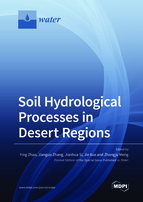Soil Hydrological Processes in Desert Regions
A special issue of Water (ISSN 2073-4441). This special issue belongs to the section "Soil and Water".
Deadline for manuscript submissions: closed (30 June 2022) | Viewed by 24904
Special Issue Editors
2. College of Natural Resources and Environment, Northwest Agriculture and Forestry University, Yangling 712100, China
Interests: soil physics; soil degradation; saline-alkaline land; hydrological modelling; agricultural productivity
Special Issues, Collections and Topics in MDPI journals
Interests: soil water–salt transport; desertification control; soil salt crust
Interests: ecohydrology; plant physiology; hydrology and water resouces in drylands
Interests: ecohydrology; restoration ecology; water resouces and cycling in drylands
Special Issue Information
Dear Colleagues,
Soil hydrology is an inter-discipline of soil science and hydrology that mainly focuses on interactive pedologic and hydrologic processes and properties. The Critical Zone is the thin layer of the Earth’s terrestrial surface and near-surface environment and plays fundamental roles in sustaining life and humanity. Desert, a unique ecosystem, becomes a more critical research area in the Earth’s Critical Zone framework but relatively less managed. There is such vast literature suggesting that we could tip the climate to a more humid and productive stage if we could vegetate that desert. Nevertheless, the significance of desert ecosystem management requires supportive and regulatory ecosystem services, ecosystem sustainability, and a feedback loop between ecological and hydrological processes. Although the benefits of reversing desertification, preventing erosion, and providing biomass have been recognized, the effects of anthropogenic revegetation on soil water and carbon cycles, among many other soil hydrogical processes, are still poorly understood. This Special Issue is open to advanced desert research on control of land degradation and desertification, climate and soil–water interactions, soil–plant–water–biota processes, the biogeochemical process for C and nutrient cycling, management of desert–oasis ecotone, critical zone observatories, and desert evolution and environment. We wish to compile research works that will show state-of-the-art and recent, cutting-edge research achievements. Theoretical, methodological, and study case papers are welcome.
Prof. Ying Zhao
Dr. Jianguo Zhang
Prof. Jianhua Si
Dr. Jie Xue
Prof. Zhongju Meng
Guest Editors
Manuscript Submission Information
Manuscripts should be submitted online at www.mdpi.com by registering and logging in to this website. Once you are registered, click here to go to the submission form. Manuscripts can be submitted until the deadline. All submissions that pass pre-check are peer-reviewed. Accepted papers will be published continuously in the journal (as soon as accepted) and will be listed together on the special issue website. Research articles, review articles as well as short communications are invited. For planned papers, a title and short abstract (about 100 words) can be sent to the Editorial Office for announcement on this website.
Submitted manuscripts should not have been published previously, nor be under consideration for publication elsewhere (except conference proceedings papers). All manuscripts are thoroughly refereed through a single-blind peer-review process. A guide for authors and other relevant information for submission of manuscripts is available on the Instructions for Authors page. Water is an international peer-reviewed open access semimonthly journal published by MDPI.
Please visit the Instructions for Authors page before submitting a manuscript. The Article Processing Charge (APC) for publication in this open access journal is 2600 CHF (Swiss Francs). Submitted papers should be well formatted and use good English. Authors may use MDPI's English editing service prior to publication or during author revisions.
Keywords
- processes
- desertification
- C and nutrient cycling
- climate
- terrestrial ecosystem










